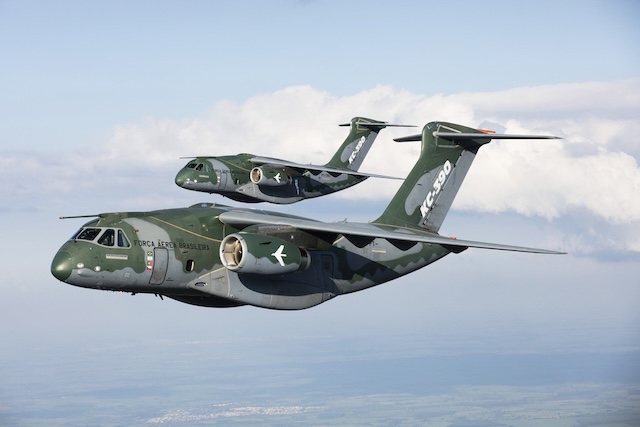C-390 Millennium
Summary
| Category | Military Transport Aircraft |
| Origin country | 🇧🇷 Brazil |
| Manufacturer | Embraer |
| First flight | 30 August 2025 |
| Year introduced | 2019 |
| Number produced | 11 units |
| Average unit price | $140 million |
Description
Work on the Embraer C-390 Millennium began in the mid-2000s, driven by the Brazilian aircraft manufacturer's ambition to develop its own medium-sized military transport aircraft. Early designs explored a high-wing derivative of the Embraer E190 jetliner, aiming for a similar size to the Lockheed C-130 Hercules but with turbofan jet engines instead of turboprops. This approach garnered support from the Brazilian government and Air Force, leading to an initial government investment of R$800 million (US$440M) in May 2008, followed by a $1.5 billion contract for two prototypes in April 2009. The aircraft, initially designated C-390, underwent a name change to KC-390 in early 2011, with plans for a stretched civilian freighter version announced later that year. Key milestones include the first prototype rollout on 21 October 2014, and the maiden flight on 3 February 2015.
The Embraer C-390 Millennium is a mid-sized utility transport aircraft engineered for operational flexibility, incorporating a modular design that enables rapid reconfiguration of both internal and external setups to suit varied mission roles. Modern technology and specialized mission software are integrated to aid crew operations, including a cockpit equipped with head-up displays, an enhanced vision system utilizing four cameras, and Rockwell Collins Pro Line Fusion commercial avionics. It can provide inflight refuelling to other aircraft through two wing-mounted probe and drogue pods from Cobham plc. Powered by a pair of IAE V2500-E5 turbofan engines mounted forward on the high wing which incorporates anhedral angle, slats, and high-lift devices, the aircraft can operate from soft, unpaved ground due to its landing gear which features low-pressure tires. The C-390 is equipped with fully fly-by-wire flight controls and active sidesticks, reducing crew workload, and includes an autothrottle system, navigation systems (INS, GPS, and TCAS), a SELEX Galileo Gabbiano tactical radar, and an Elbit Systems directional infrared countermeasures suite for self-defense. An integrated onboard maintenance system actively monitors the aircraft's health and its subsystems. The hold of the C-390 is accessed via a rear ramp and can accommodate payloads up to 26 t (57,000 lb).
The C-390 Millennium features hardpoints for the carriage of various types of ordnance, enhancing its mission versatility. It possesses three hardpoints designed to accommodate POD Optical/IR Rafael Litening II systems and IFR Cobham 900E in-flight refueling pods. Additionally, the aircraft can be equipped with RWR (Radar Warning Receiver) systems, chaff and flare dispensers, and DIRCM (Directional Infrared Countermeasures) for self-defense.
In 2014, the Brazilian government ordered 28 C-390s with the intention of progressively replacing the Brazilian Air Force’s existing cargo aircraft fleet, including its C-130s. The first production aircraft was delivered to the Brazilian Air Force on 4 September 2019 and will be operated from Anápolis Air Force Base by the 1st Troop Transportation Group (1º GTT) Zeus, and in Rio de Janeiro by the 1st/1st GT Gordo. During the initial 3.5 years of operation, the C-390 in the FAB totaled more than 8,200 flight hours with 6,000 flights, achieving a technical availability of around 80% and a mission completion rate of 99.5%, according to Embraer data and the FAB. In January 2021, the aircraft played a crucial role in airlifting supplies and patients during the COVID-19 pandemic in Manaus, Brazil. Following the 2020 Beirut explosion, a C-390 and an Embraer 190 VC-2 were dispatched with essential supplies for emergency care, marking the aircraft’s first international mission in FAB service. In February 2021, the KC-390 participated in Operational Exercise "Culminating" in Louisiana, conducting joint flights with US Air Force C-17 and C-130 airlifters, launching 4,000 paratroopers in a single night jump, and after the Haiti earthquake, it transported medicine and firefighting equipment. The C-390 has also supported operations in Antarctica, the rescue of Brazilian nationals in Ukraine, and humanitarian aid missions. However, in February 2022, the Brazilian government downsized its order for C-390s to 22 aircraft due to financial austerity measures. In October 2023, among its first missions in the Portuguese Air Force, the C-390 transported military personnel and cargo to the Canary Islands, Spain, in support of the multinational Spanish-led exercise Ocean Sky 2023. It then progressed to the United States where it picked up one of the Black Hawk helicopters procured by Portugal.
Main Variants:
-
C-390: The standard model of the aircraft is designed for versatile operations including transport, search and rescue (SAR), and aerial firefighting.
-
KC-390: This variant is specifically configured for aerial refueling, serving as a tanker aircraft, and was initially developed for the Brazilian Air Force.
-
C-390 IVR: Announced in December 2024, this anti-submarine and maritime patrol variant is under consideration for joint development between Embraer and the Brazilian Air Force to replace the Lockheed P-3 Orion fleet.
Technical specifications
| Version: KC-390 | |
|---|---|
| Maximum speed | 980 km/h (609 mph) |
| Wingspan | 35.1 m (115.0 ft) |
| Height | 10.3 m (33.7 ft) |
| Length | 33.9 m (111.3 ft) |
| Service ceiling | 11,000 m (36,089 ft) |
| Max. takeoff weight | 72,000 kg (158,733 lbs) |
| Powerplant | 2 x turbojets IAE V2500-E5 delivering 13154 kgf each |
Current operating countries
| Country | Units | ||
|---|---|---|---|

|
Brazil | 7 (+12) | |

|
Portugal | 3 (+3) | |

|
Hungary | 1 (+1) | |

|
Netherlands | 0 (+5) | |

|
Austria | 0 (+4) | |

|
South Korea | 0 (+3) | |

|
Czech Republic | 0 (+2) | |
All operators

